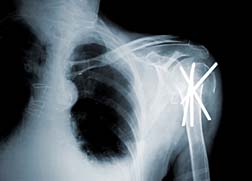 PAGCL is an extremely painful condition that results in decreased mobility of the affected shoulder. It occurs due to damage of the cartilage, which is vital for shoulder mobility. Pain occurs when the cartilage between the humeral head and the glenoid is broken down, resulting in bone-on-bone contact.
PAGCL is an extremely painful condition that results in decreased mobility of the affected shoulder. It occurs due to damage of the cartilage, which is vital for shoulder mobility. Pain occurs when the cartilage between the humeral head and the glenoid is broken down, resulting in bone-on-bone contact.One of the main concerns about PAGCL is that it affects people who are young and otherwise are in good health. In fact, a study of patients referred to Duke University Medical Center for severe chondrolysis showed all six patients were between the ages of 15 and 32. All patients also required shoulder replacement surgery.
Furthermore, a paper by Hansen and colleagues, referred to at Medscape Today, noted in a study that all patients included in the study who developed PAGCL had been treated with a shoulder pain pump that contained bupivacaine with epinephrine. The shoulder pain pump was the only factor found to be in common among the patients. All patients received the medication at 4.16 cc/hour for two to three days. Eighty-three percent of the patients who developed PAGCL in the study required subsequent procedures to treat the pain.
READ MORE LEGAL NEWS
In severe cases, patients require an entire shoulder joint replacement to manage the PAGCL. The procedure, known as arthroplasty, uses parts made of plastic and metal to replace the shoulder joint. Other patients require constant medication to manage the pain.
One study has already linked the use of shoulder pain pumps to PAGCL and further studies are underway to confirm those findings. In the meantime, doctors are encouraged to use shoulder pain pumps with caution until more information about their link to PAGCL is obtained.
